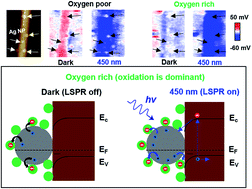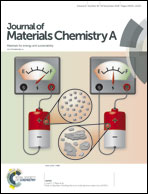A hot-electron-triggered catalytic oxidation reaction of plasmonic silver nanoparticles evidenced by surface potential mapping†
Abstract
Localized surface plasmon resonance (LSPR) can be used to promote a catalytic oxidation reaction in metal nanostructures. The activation of oxygen on the metal nanostructures is predicted in this reaction by hot electrons transferring from the metal nanostructure to the oxygen, which results in a negatively charged state of the oxygen-adsorbed metal nanostructure. While the detailed mechanism of the catalytic oxidation reaction of metal nanostructures under LSPR conditions attracts much attention for performance improvement of the metal nanostructures as catalysts, the characterization of plasmon-induced charge separation/transfer (PICS) on the metal nanostructures is still challenging due to its limitations and the high difficulty of characterization tools. In this letter, the catalytic oxidation reaction of Ag nanoparticles (NPs) under LSPR conditions is demonstrated with direct observations via light-irradiated Kelvin probe force microscopy (KPFM) measurements. Both isolated Ag NPs and Ag NPs attached on a semiconducting polypyrrole (PPy) nanowire (NW) are utilized to observe the catalytic oxidation reaction of Ag NPs under LSPR conditions. By controlling the environment of Ag NPs attached to the PPy NW from de-oxidation (oxygen poor) to oxidation (oxygen rich) and vice versa, oppositely changed charge states of plasmonically excited Ag NPs (positively and negatively in order) attached on the PPy NW can be directly observed by the nanoscale surface potential mapping of the light-irradiated KPFM. Importantly, the directly observed negatively changed charge state of the Ag NPs attached on the PPy NW under LSPR conditions with oxygen exposure (the environment of water and air) indicates the activation of oxygen on the Ag NPs by accepting electrons. This direct observation of the acceptor-behavior of the oxygen on the Ag NPs under LSPR conditions reveals that electrons work as a majority carrier for the catalytic oxidation reaction of plasmonic metal nanostructures. Moreover, this finding suggests a way to develop highly efficient metal nano-photocatalysis.



 Please wait while we load your content...
Please wait while we load your content...